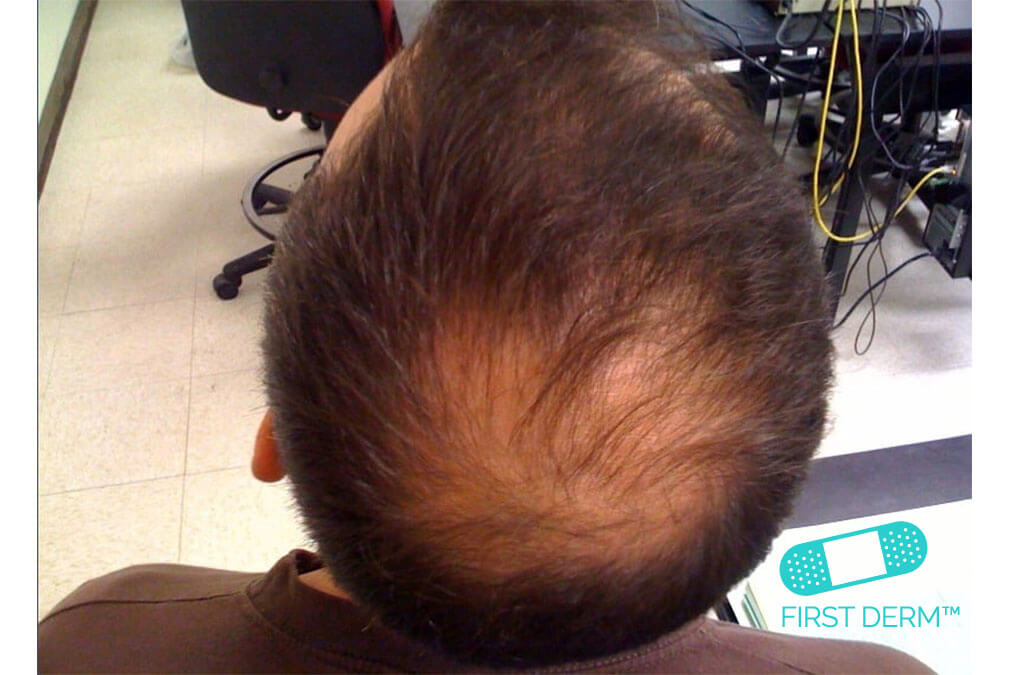
Hair Loss – Alopecia Areata in men
Hair loss is a common complaint among patients who go to see dermatologists. There are many causes of hair loss, however, and discovering the cause is critical to selecting the appropriate treatment. Discovering the cause of hair loss can be difficult, and your dermatologist will rely on subtle cues from your history, physical exam, laboratory studies, and perhaps a scalp biopsy. Here, I will discuss five of the most important or interesting causes of hair loss.
Ask a dermatologist about hair loss today!
1. Androgenic alopecia
Androgenic alopecia is the cause of common “male pattern baldness.” Men often notice a thinning of their hair on the crown of their scalp in addition to a receding hairline. The most effective initial treatments are Rogaine and Propecia. New products are currently being investigated, including the use of the eyelash product Latisse. There are also surgical options for treatment, such as hair transplantation.
Androgenic alopecia is also a common cause of hair loss in women. Women with androgenic alopecia notice thinning hair over the whole top of their scalp, but do not get a receding hair line. Women with androgenic alopecia often are overweight, have irregular menstrual periods, and may have a condition called Polycystic Ovarian Syndrome. Like men, women can also use Rogaine to help with hair growth.
Ask a dermatologist about hair loss today!
2. Alopecia areata
Alopecia areata is an autoimmune condition where your own body’s immune cells attack hair follicles. Most often, this leads to oval shaped patches of complete hair loss. This can affect any hair-bearing region of the body, including eyebrows/lashes and body hair. Alopecia areata is unpredictable—it can go away on its own, or it can expand to involve all the hair on the body. Dermatologists see this condition frequently, and often treat it with injections of steroids into the areas without hair in order to decrease the autoimmune reaction.
3. Alopecia as a result of underlying medical conditions
Many underlying medical conditions can cause hair loss. Thyroid problems are a common culprit, but low iron, low zinc, and vitamin D deficiency can be to blame as well. Your dermatologist can take a blood sample to test for these deficiencies. Furthermore, serious illness, stress, pregnancy, crash diets, and other stressors can cause a condition called Telogen Effluvium where you shed all the hair on your body. This hair grows back once the stressor has ended.
Ask a dermatologist about hair loss today!
4. Central Centrifugal Cicatricial Alopecia and Traction Alopecia
These two related conditions are common causes of hair loss in African Americans, especially in females. This hair loss is a result of years of tight braids, hot comb use, and use of relaxers and perms. The result is scarring hair loss at the periphery of the scalp. The best treatment is to avoid whatever practices are damaging the hair. This is a scarring hair loss, meaning that the openings of the hair follicles are completely scarred over. This makes treatment difficult, but many patients notice improvement with injection of steroids into the scalp by a dermatologist. Rogaine may also be helpful.
Ask a dermatologist about hair loss today!
5. Trichotillomania
This is a rare form of hair loss often seen in children. Due to a psychological stressor, these children actually pull out their hair. This may be a subconscious defense mechanism, meaning that the child may not even be aware that he or she is pulling their hair out. It also commonly affects the eyebrows and eyelashes. Sometimes, the children will even eat the hair, which can cause digestive problems (this condition is called Trichotillophagia). The build up of indigestible hair in the stomach can cause obstruction of the GI tract, requiring surgical removal of a large ball of hair that has been collecting over months to years. A dermatologist can identify this disorder by looking at the childs’s scalp with a dermatoscope. Treatment involves educating the parents and addressing any psychological stressors the child may be facing.
Written by: Dennis Porto, MD

The Specialist doctor from the University Hospital in Gothenburg, alumnus UC Berkeley. My doctoral dissertation is about Digital Health and I have published 5 scientific articles in teledermatology and artificial intelligence and others.

